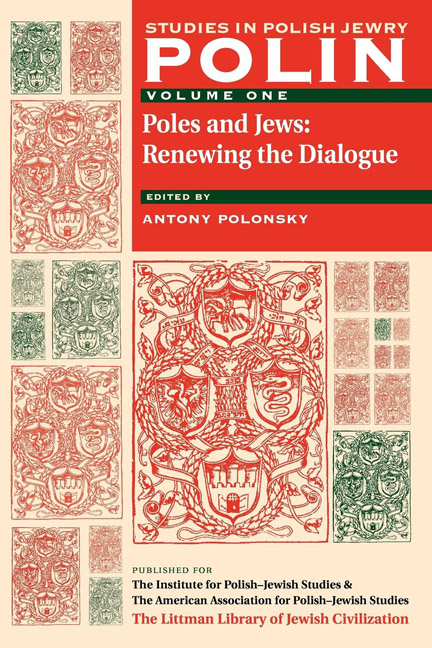Book contents
- Frontmatter
- Dedication
- Editors and Advisers
- Contents
- Polin
- Statement From the Editors
- ARTICLES
- The Reconstruction of Pre-Ashkenazic Jewish Settlements in the Slavic Lands in the Light of Linguistic Sources
- Jewish Perceptions of lnsecurity and Powerlessness in 16th-18th Century Poland
- Some Basic Characteristics of the Jewish Experience in Poland
- The Changes in the Attitude of Polish Society Toward theJews in the 18th Century
- Eros and Enlightenment: Love Against Marriage in the East European Jewish Enlightenment
- Polish-Jewish Relations and the January Uprising: The Polish Perspective
- Loyalty to the Crown or Polish Patriotism? The Metamorphoses of an Anti-Polish Story of the 1863 Insurrection
- The Polish Revolt of 1863 and the Birth of Russification: Bad for the Jews?
- A Turning Point in the History of Polish Socialism and its Attitude Towards the Jewish Question
- The Question of the Assimilation of Jews in the Polish Kingdom (1864-1897): An Interpretive Essay
- The Secular Appropriation of Hasidism by an East European Jewish Intellectual: Dubnow, Renan, and the Besht
- Some Methodological Problems of the Study of Jewish History in Poland Between the Two World Wars
- Jews and Poles in Yiddish Literature in Poland Between the Two World Wars
- Is There a Jewish School of Polish Literature?
- The Underground Movement in Auschwitz Concentration Camp
- DOCUMENTS
- INTERVIEW
- A DIALOGUE
- BIBLIOGRAPHICAL ESSAYS
- BOOK REVIEWS
- CONTRIBUTORS
Jews and Poles in Yiddish Literature in Poland Between the Two World Wars
from ARTICLES
- Frontmatter
- Dedication
- Editors and Advisers
- Contents
- Polin
- Statement From the Editors
- ARTICLES
- The Reconstruction of Pre-Ashkenazic Jewish Settlements in the Slavic Lands in the Light of Linguistic Sources
- Jewish Perceptions of lnsecurity and Powerlessness in 16th-18th Century Poland
- Some Basic Characteristics of the Jewish Experience in Poland
- The Changes in the Attitude of Polish Society Toward theJews in the 18th Century
- Eros and Enlightenment: Love Against Marriage in the East European Jewish Enlightenment
- Polish-Jewish Relations and the January Uprising: The Polish Perspective
- Loyalty to the Crown or Polish Patriotism? The Metamorphoses of an Anti-Polish Story of the 1863 Insurrection
- The Polish Revolt of 1863 and the Birth of Russification: Bad for the Jews?
- A Turning Point in the History of Polish Socialism and its Attitude Towards the Jewish Question
- The Question of the Assimilation of Jews in the Polish Kingdom (1864-1897): An Interpretive Essay
- The Secular Appropriation of Hasidism by an East European Jewish Intellectual: Dubnow, Renan, and the Besht
- Some Methodological Problems of the Study of Jewish History in Poland Between the Two World Wars
- Jews and Poles in Yiddish Literature in Poland Between the Two World Wars
- Is There a Jewish School of Polish Literature?
- The Underground Movement in Auschwitz Concentration Camp
- DOCUMENTS
- INTERVIEW
- A DIALOGUE
- BIBLIOGRAPHICAL ESSAYS
- BOOK REVIEWS
- CONTRIBUTORS
Summary
The beginnings of modem Yiddish literature, in east European Yiddish, are to be found at the end of the eighteenth century within the borders of pre-partition Poland. With the waves of emigration from the second half of the nineteenth century, Yiddish literature became an extra-territorial literature as considerable numbers of its writers and readers dispersed across western Europe and the Americas. Until and even beyond World War II, eastern Europe has continued to be almost the sole birthplace of Yiddish writers despite the dispersion of the authors and audience of this literature. The Jewish centres outside of eastern Europe have not produced native-born Yiddish writers; in fact Yiddish literature exists in these centres only insofar as Yiddish-speaking immigrants have maintained it.
Despite regional differences and ties to a dominant territorially-defined culture and literature, it is possible to regard Yiddish literature in eastern Europe until World War I as more or less a uniform field in relation to its ideological and artistic trends, and readership. Sh. Y. Abramovitch or Mendele Moykher Sforim (1836-1917) from Odessa, Sholem Aleichem (1859-1916) from Kiev and Y. L. Peretz (1852-1915) from Warsaw-three writers whose works are considered classics of modem Yiddish literature - wrote and worked with a sense of belonging to one literature for one audience. Yet, each one came from a different dialectical region of eastern European Yiddish; a review of the writings of Abramovitch and Sholem Aleichem reveals clear ties to Russian literature, while in the writings of Peretz an intimate knowledge of Polish literature is evident. This sense of a shared heritage was also preserved in the lands of immigration.
After World War I, a schism began to divide the two major centres of Yiddish literature in eastern Europe. In independent Poland, a centre of Yiddish literature arose which possessed clear signs of singularity. Although there were many contributing factors, it is the political factor - that is, the isolation of the other great centre of Yiddish literature in eastern Europe, the Soviet centre - which is most pertinent. Ideological pressure was so strong that as early as the end of the 1920s a substantial barrier separated the Moscow and Warsaw literary centres.
- Type
- Chapter
- Information
- Poles and Jews: Renewing the Dialogue , pp. 176 - 195Publisher: Liverpool University PressPrint publication year: 2004



